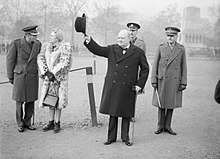Bertram Sergison-Brooke
Lieutenant General Sir Bertram Norman Sergison-Brooke, KCB, KCVO, CMG, DSO (born Brooke; 20 July 1880 – 26 March 1967) was an Anglo-Irish senior British Army officer who served as Major-General commanding the Brigade of Guards and General Officer Commanding London District.[1]
Sir Bertram Sergison-Brooke | |
|---|---|
 Sergison-Brooke (right) with Churchill in London, January 1941 | |
| Birth name | Bertram Norman Brooke |
| Born | 20 July 1880 St George Hanover Square, London |
| Died | 26 March 1967 (aged 86) Brackley, Northamptonshire, England |
| Allegiance | United Kingdom |
| Service/ | British Army |
| Years of service | 1899–1942 |
| Rank | Lieutenant General |
| Commands held | London District 1st (Guards) Brigade 15th Infantry Brigade Grenadier Guards 1st Battalion Grenadier Guards 2nd Guards Brigade |
| Battles/wars | Second Boer War First World War Second World War |
| Awards | Knight Commander of the Order of the Bath Knight Commander of the Royal Victorian Order Companion of the Order of St Michael and St George Distinguished Service Order Mentioned in Despatches Order of the Crown (Belgium) Legion of Honour (France) |
Early life and education
Brooke was born in London, the fourth son of Arthur Basil Brooke and Alice Georgina Norton. He was a grandson of Sir Arthur Brooke, 2nd Baronet. The Brookes were a prominent Anglo-Irish family that had been settled in Northern Ireland since prior to the Plantation of Ulster. He was educated at Eton College and passed out of the Royal Military College, Sandhurst in 1899.[2]
Military career
Brooke was commissioned into the Grenadier Guards as a second lieutenant on 12 August 1899.[3] He served in the Second Boer War in South Africa, and was promoted to lieutenant on 14 December 1900.[4] Following the end of the war in June 1902 he returned with most of the men of the guards regiments on board the SS Lake Michigan, which arrived in Southampton in October 1902.[5] He then served with the Egyptian Army.[3]
He also served in the First World War, initially as Assistant Embarkation Officer in Southampton and then as a Brigade Major in France.[3] By 1917 he was commanding 2nd Guards Brigade but was gassed on the Western Front.[6]
After the war he became Commanding Officer of the 1st Battalion Grenadier Guards and then, in 1923, went on to be Commander of the Grenadier Guards and Regimental District.[3] He was appointed Commander of 15th Infantry Brigade in China in 1927 and then Commander of the 1st (Guards) Brigade at Aldershot in 1928.[3] He was made Brigadier on the General Staff at Eastern Command in India in 1931 and Major-General commanding the Brigade of Guards and General Officer Commanding London District in 1934.[3] He retired in 1939 but, with the Second World War underway, he was recalled as General Officer Commanding London District.[3] He retired again in 1942.[3]
He was British Red Cross Commissioner with the Allied Army of Liberation from 1943 to 1945.[3]
Personal life
In 1915, he married Prudence Ida Evelyn Sergison, daughter and co-heiress of Charles Warden Sergison of Cuckfield Park, and assumed her surname by royal licence. They had one daughter, Patience Ann (born 1916), who married Sir Edward Henry Windley.[7]
After Prudence's death in 1918, he married secondly Hilda Fenwick, in 1923. They had one son, Timothy Mark, who married Hon. Mary Anne Hare, daughter of John Hare, 1st Viscount Blakenham.[7] His second wife died in 1954.[1]
His home was in Slaugham in West Sussex.[8]
References
- "Obituary: Gen. Sergison-Brooke". The Times. The Times Digital Archive. 28 March 1967. p. 10.
- Debrett's Peerage, Baronetage, Knightage, and Companionage. Kelly's Directories. 1916. p. 92. Retrieved 30 May 2019.
- Sir Bertram Norman Sergison-Brooke Liddell Hart Centre for Military Archives
- Hart's Army list, 1903
- "The Army in South Africa – Troops returning home". The Times (36876). London. 18 September 1902. p. 5.
- "Centre for War Studies". University of Birmingham. Retrieved 11 June 2019.
- Mosley, Charles, ed. (2003). Burke's Peerage, Baronetage & Knighthood (107 ed.). Burke's Peerage & Gentry. p. 526. ISBN 0-9711966-2-1.
- 'Parishes: Slaugham', A History of the County of Sussex: Volume 7: The rape of Lewes (1940), pp. 181–186 Date accessed: 14 June 2010
| Military offices | ||
|---|---|---|
| Preceded by Sir Charles Grant |
GOC London District 1934–1938 |
Succeeded by Sir Andrew Thorne |
| Preceded by Sir Andrew Thorne |
GOC London District 1939–1942 |
Succeeded by Sir Arthur Smith |